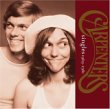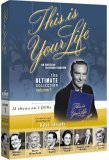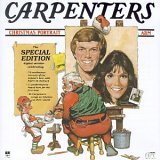What can you say about the Carpenters that hasn’t already been said? It would seem that the answer to that question is: “Not a lot.”. And yet…
Things Aren’t Always What They Seem
On stage and in public, they appeared to be every mother and father’s dream children – clean-cut, wholesome, attractive. Off stage, in private, they were just like everyone else, with good days and bad days, challenges and issues, conflicts with their parents and with each other.
Life Happens – Even to Carpenters
By the mid to late 1970’s, Richard had developed an addiction to Quaaludes. A doctor had prescribed them as a way to help him get to sleep after those long, frenetic days at the studio or on the road. And they worked. But his body built up a tolerance to them and he soon was hooked.
Karen had developed an “addiction” of her own.. an addiction to being impossibly thin. Both finally went for treatment.
Richard recovered with the help of a six-week stay at a rehab facility. Karen’s anorexia led to her death in 1983 at the age of 32. And while Karen’s story has helped to get many young women and even some young men, into treatment for the disease, enough has been written elsewhere about the details of their illnesses. We do list sites below where you can find that information, including a site with many links to resources on eating disorders.
The Personal Stuff
Richard Carpenter was the musical prodigy in the family, able to sit down at a piano and play just about any song he heard by ear. He was born October 15, 1946 in New Haven, Connecticut. Sister Karen followed on March 2, 1950. Richard’s musical tastes were formed early, listening to his father’s extensive collection of recordings and later, on the radio. Among his favorites, Nat King Cole, Patti Page, Perry Como, Red Nichols and Spike Jones.
Piano Man
Richard began formal training on the piano at the age of eight and was playing gigs by the time he was 15, as part of a trio.
The family moved to the Los Angeles area in 1963 where Richard impressed the band director at Downey High School with his piano skills. Bruce Gifford invited Richard to join his own band, playing dates in the Downey area.
Sister Karen, meanwhile, was starting to get interested in music. She picked up the glockenspiel in 1964, telling interviewers later that her motive in joining the high school band was as a way to get out of gym. A drummer in that band, Frankie Chavez, became her inspiration. She was a natural!
The Richard Carpenter Trio
Soon after, when Karen was 15, the Carpenter Trio was formed. Karen, Richard and a classmate, Wes Jacobs, got together to play jazz. Wes played tuba and bass. Karen sang occasionally.
In 1966, the brother and sister act auditioned for bassist Joe Osborn, for a new label he had launched, Magic Lamp. He signed them to a contract and Magic Lamp issued two songs, written by Richard, sung by Karen, “Looking for Love” and “I’ll be Yours”. The Magic Lamp quickly went out, however, and the single went nowhere.
That was the bad news. The good news was that the Richard Carpenter Trio won the Hollywood Bowl Battle of the Bands that year, favorable comments from Los Angeles Times music critic Leonard Feather, and a short-lived contract with RCA Records. However, the producer who signed them was about the only one at RCA who liked the trio. The group split up soon after the contract with RCA ended.
Disneyland
Jacobs went off to Julliard and Richard teamed up with a fellow member of the choir at California State University, Long Beach, John Bettis. The two were both working at a Disneyland snack shop called the “Coke Corner”, and were supposed to be playing old standards. They veered off into more contemporary tunes and management didn’t like that much. They were fired after four months, but the partnership of Bettis and Carpenter continued for years with the two responsible for writing some of the Carpenter’s biggest hits, including “Top of the World”.
Spectrum
Richard, Karen and John Bettis now formed, briefly, a group called Spectrum, joined by three others. Their brand of musical harmony couldn’t compete with the popular rock bands, so, once again, it was so long, group, hello, Richard & Karen.
Enter Carpenters
This is where Richard decided that he and his sister were enough. They didn’t need a band around them. And so, they became Carpenters, not “The” Carpenters. Richard thought that the name, without the prefix would be “hipper”.
Their big break came on the TV show, “Your All American College Show”. Karen and Richard hooked up with bassist Bill Sissyoev, specifically for the auditions, and blew away the competition. The appearance won them an audition and a contract for a Ford commercial.
This Guy’s In Love
They signed the deal in 1969.. around the same time that Herb Alpert happened to listen to one of their demo tapes. Karen’s voice surrounded by Richard’s arrangements evoked an emotional response in Alpert. He fell “in love with the voice, the harmonies and the arrangements”, and signed Richard and Karen to a deal with his A&M Record label. The Ford commercial contract was torn up and the Carpenters’ musical rocket was on the launching pad.
“Close to You”
The first release was the Beatles “Ticket to Ride” but done in a way that some say redefined the song. Richard’s arrangement is a ballad, showcasing Karen’s voice and featuring overdubbed harmonies sung by both Carpenters. It got a lot of attention, tho it didn’t climb very high on the charts.
But the next song would shoot to number 1, selling three million copies. It was the Burt Bacharach/Hal David song, “They Long to be Close to You”. Richard shortened the title, added harmonies to Richard’s arrangement and the world joined Herb Alpert in love with the duo.
Their next million seller was originally written for a television ad campaign for a California bank. Richard reworked the arrangement for “We’ve Only Just Begun”, and Karen’s lovely vocal helped send the song to number 2 on the charts. The song is still played at weddings and joins “Close to You” as the two songs most people think of when they think of the Carpenters.
Making Their Own Kind of Music
The early 70’s were heady times for the Carpenters. They were one of the most popular recording acts in the world, won two Grammys, including Best New Artist in 1970, and turned out a series of Top Ten hits – “Rainy Days and Mondays”, “Superstar”, “Hurting
Each Other”, “Goodbye to Love”, “Yesterday Once More”, and “Top of the World”.
Fame was a mixed blessing, and Richard has written that he thought they were too young.. 1971 brought with it a summer replacement TV series, “Make Your Own Kind of Music”, and an appearance on the popular TV show “This is Your Life”.
This is Your Life
The Carpenters were surprised by host Ralph Edwards while they were in conference with Herb Alpert at an A&M Records studio. (It’s not clear from watching the show whether Alpert was in on the surprise or whether he thought that he might be the subject!).
The show includes visits from some of those people who had helped the two in those early years. Among them, Frank Pooler, choir director at CSU, Long Beach. He wrote the words for “Merry Christmas, Darling” and persuaded Richard to compose the music. (The show is among those featured on Volume 1 of “This is Your Life, the Ultimate Collection”, available on DVD and VHS.)
White House Performance
In 1973, they performed at the White House by invitation of then-President Richard Nixon.
The early 70’s would leave both Carpenters exhausted, what with recording dates, tv specials and world tours. Karen’s obsession with getting and staying thin would emerge in late 1973 and her weight would drop to just 91 pounds two years later. 1975 brought the “Carpenters Very First TV Special” with John Denver and Victor Borge as special guests. The next four years would bring five more TV specials.
Can We Stop Hurting Each Others?
1976 was the year that Richard faced his dependence on Quaaludes but it would be another two years before he actually did something about it. The addiction was affecting his work.
He hired arrangers Peter Knight and Billy May to handle the songs for the “Christmas Portrait” album and he just produced the sessions.
Richard went into rehab in 1979 and took the rest of the year off to recover.
Karen spent some time in a hospital that year as well, as a result of her anorexia, but she was determined to make a solo album, joining up with producer Phil Ramone in New York.
The result was not what A&M had hoped for and the project was shelved. It was released years after her death, in 1996, as Karen Carpenter and features a very different, more grown up and sexier sound.
Made in America
Richard and Karen made their final album in 1980, and it was released in 1981.
Made in America includes “Because We Are In Love”, the song which John Bettis and Richard wrote, at Karen’s request, for her 1980 wedding to real estate tycoon, Tom Burris, a marriage that soon ended in separation and would have resulted in divorce, had Karen lived just a few more days.
Not Really the End
Karen’s death was a huge shock for her fans, friends and parents but especially so for Richard. He returned to the studio later in 1983 and put together an album of alternative takes, released as Voices of the Heart. An Old Fashioned Christmas was released in 1984, featuring songs that were left off Christmas Portrait.
Other retrospectives have followed through the years. In 1994, marking the 25th anniversary of the duo’s signing with A&M records, a tribute album titled If I Were a Carpenter was released.
It features various artists including Sonic Youth, Cracker and Sheryl Crow, doing Carpenters songs. (It’s actually quite interesting, though be aware that most of these artists are what might be termed “alternative”!)
Yesterday, Once More
Karen died more than 20 years ago. Since then, both parents have died – Harold in 1988, Agnes in 1996. Richard has continued his musical career. He is now married, with children, living in California, performing and producing. He and his wife recently donated 3 million dollars to the Thousand Oaks Civic Arts Plaza. In 1994, The Richard and Karen Carpenter Performing Arts Center at California State University, Long Beach was established at his and Karen’s alma mater. Richard continues to support that facility.
He also has renamed The Karen Carpenter Foundation, set up after her death. It is now the Carpenter Family Foundation, funding a variety of causes. It’s mission is to help build a better environment for children and better health care for families.
And the popularity of the Carpenters recordings continues. Their albums, now on CD, continue to sell, with The Singles 69-73 being the best seller, world-wide. And Karen’s remarkable voice and style, her presence, beautifully showcased by Richard’s music and arrangements, still leap out of the speakers today, just as they did for Herb Alpert when he first heard her on a demo. Listen to samples of some of the songs you may not know they recorded like “Jambalaya” or ones you may be more familiar with, like the booming bass of “Want You Back in My Life Again” and marvel at the beauty of the melodies and the harmonies that came together in those recordings.
Richard’s website details his beliefs about why the Carpenters were so popular, even in the hey-day of psychedelic rock, and why their music endures. Essentially, he says that not all baby boomers were hooked on rock. They wanted music with melodies and lyrics you could understand, “adult” music, a more contemporary kind of pop, and the Carpenters were among the first to provide it.
Great Resources
Some of the most interesting, topical information about the brother and sister who had such an impact on pop music can be found on Richard’s own website, RichardandKaren
Carpenter.com, especially in his responses to questions from fans. The site features a lengthy biography of Richard and Karen, along with updates on what Richard and his wife and children are doing these days. There are photos of three of the children and Richard performing at the 10th Birthday celebration of the Center, in fall, 2004. One especially nice feature is the album liner notes and in some cases, song notes, that Richard has provided for the Carpenters recordings, giving additional insight into the music and the lives of the two at the time of the recording.
The site confirms that Karen’s remains are now interred in Pierce Brothers Valley Oaks Memorial Park in Westlake Village, California. His site provides contact information for fans wishing to send flowers to be placed at her crypt.
This site: LeadSister.com is clearly a labor of love. It’s dedicated to Karen and takes it’s name from a t-shirt Karen wore reading “Lead Sister”, a play on “Lead Singer”. The site is filled with information including photos and quotes from the newsletter issued by the Carpenters’s fan club/publicity crew back in the ’70s and ’80s. It also has a collection of articles and interviews, including the one that appeared in People magazine after Karen’s death. There is a forum that’s not in heavy use, and there are links to sites to help those with eating disorders. Well worth a visit.
And for a basic overview of the Carpenters, one you can edit yourself, if you have anything to add, visit the Wikipedia.
(Clicking on any of these links will open a new browser window for you, so that you won’t lose The Breeze. To get back to us, just close that new window and we will still be there.)









